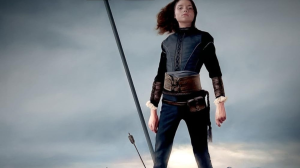Everyone knows that Stanley Kubrick is famous for his obsession with technical and visual precision in his films. Every shot, every camera movement, every edit is planned with almost extreme meticulousness – and The Shining is no exception. His iconic adaptation of Stephen King’s novel is filled with unforgettable imagery that has become etched in pop culture – the endless hallways of the Overlook Hotel, the twins standing side by side, the elevator bursting with blood, and, of course, Jack Nicholson breaking through a door with an axe.
Videos by ComicBook.com
However, there’s one moment in The Shining that few people recognize as a visual effects achievement: the shot of the model maze with Danny and Wendy walking in its center.
This scene takes place roughly halfway through the movie, when Wendy (Shelley Duvall) and Danny (Danny Lloyd) decide to explore the hotel’s real maze, while Jack (Nicholson) remains alone inside, growing increasingly unstable and withdrawn. We see him walking through the main lobby and approaching the model maze, placed on a large table. The camera slowly begins to zoom in toward the center of the model, until we unexpectedly see two small human figures walking inside it – Danny and Wendy. At first glance, it appears to be a straightforward aerial shot, perhaps done with a telephoto lens or zoom. But in reality, what we’re seeing is an incredibly clever visual trick – almost imperceptible – crafted by a master of cinematic illusion. And what’s most impressive is that it was done entirely without computer-generated effects.

Kubrick, unlike many directors of his time, avoided using post-production visual effects whenever possible. He preferred practical, in-camera techniques that offered a greater sense of realism. But in this particular instance, image compositing was necessary – a process that, at the time, demanded careful planning and a precise execution.
Filming records and crew interviews reveal that the shot begins with the camera filming a miniature model of the maze from above. This model was captured with the camera positioned about six feet overhead, allowing for a broad, top-down view. Then, a life-sized version of the maze’s central area was constructed next to an apartment complex. Duvall and Lloyd were filmed walking through this full-scale section while the camera recorded from the roof of the building, replicating the same overhead angle. The two shots were then composited using mask plates – an early technique that predates green screens and involves “cutting out” a portion of one image to overlay another, creating the illusion that both elements belong in the same space.
[RELATED – 45 Years later, A Major The Shining Discovery Has Been Made]
In other words, what looks like one continuous shot is actually two separate scenes cleverly stitched together. It’s executed so seamlessly that most viewers don’t realize they’re watching a composite. The camera guides the viewer’s eye with a smooth zoom toward the model, until the figures appear. The lighting, perspective, and motion align so precisely that it creates a near-perfect illusion – something rare for visual effects of that era.
So why did Kubrick go to such lengths instead of simply filming the real maze from above? The answer lies in the film’s visual symbolism. The Shining is full of layered metaphors. The maze, in particular, serves as one of the story’s central symbols: it reflects Jack’s deteriorating mental state, cycles of violence, psychological entrapment, and even the structure of the narrative itself, full of twists, repetition, and mirrored elements. By showing Wendy and Danny inside the maze from an elevated, distant perspective – as if they were miniature figures – the movie makes it harder to tell where the model ends and the real maze begins. Kubrick subtly implies that the characters are caught within a designed system, like subjects in an experiment. It’s no wonder many scholars interpret the Overlook Hotel as a supernatural or metaphysical space.

In this way, the shot isn’t just a technical achievement – it’s a narrative and aesthetic statement. What’s surprising is that, despite its complexity, this moment is rarely mentioned in discussions about The Shining‘s visual effects. Most of the focus tends to fall on the Steadicam work (which truly did revolutionize camera movement), the elevator blood scene (achieved with actual tanks, no CGI), or the ghostly makeup. Yet, this understated transition between model and full-scale maze deserves recognition exactly because of how subtle and ingenious it is.
Today, it might seem like a minor detail, especially in an age when digital effects can create virtually any scenario imaginable. But at the time The Shining was released, this was quite innovative. It’s a reminder of a period when cinematic magic relied entirely on analog techniques, careful coordination, and the patience of directors like Kubrick. And perhaps it’s precisely because the effect was so flawless that it went unnoticed for so long.
What’s especially interesting is how this detail mirrors the film’s own structure: it’s always there, but only noticed by those who choose to look more closely – a fitting reflection of the mystery that The Shining itself represents.
The Shining is available to stream on Max.








